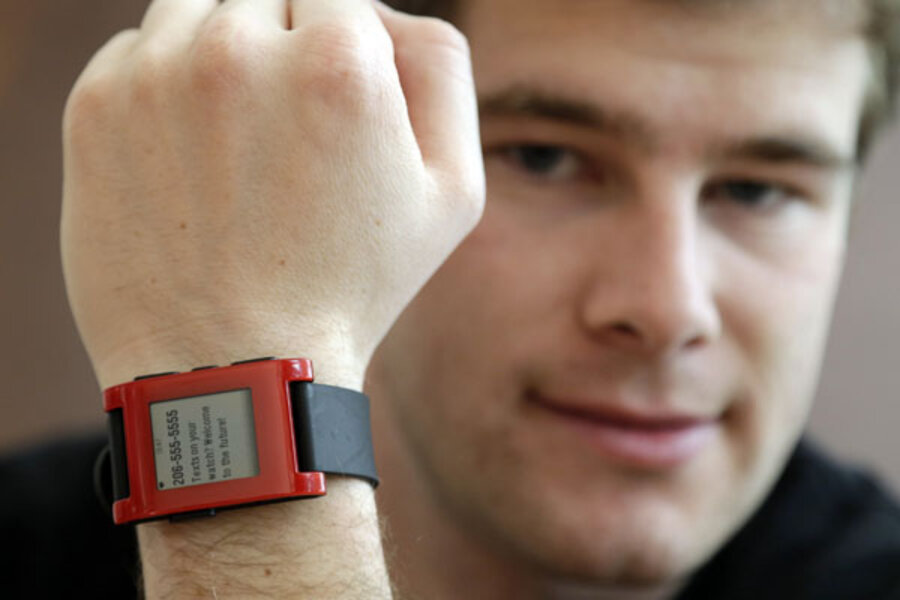Rise of the smart watch: Dick Tracy would've loved the Pebble
Loading...
When Jason Sapara gets a text message, he doesn't reach for his phone. He looks at his wrist.
Mr. Sapara wears a Pebble smart watch. The digital wristwatch wirelessly connects to Apple and Android phones. When calls, texts, or e-mails roll in, they appear on the watch. This simple convenience has already saved his bacon on a few occasions.
"When my phone is in my pocket, I never feel or hear a text message come in," says the co-founder and chief technology officer for the crowdfunding website Pikatik in Saskatoon, Saskatchewan. "Somehow, my wife has an uncanny knack to always text message me something that's very important while I'm out. Quality of life has already improved because I always feel the watch vibrate."
Before the Pebble, time seemed to be running out for wristwatches. Luxury timepieces remain as status symbols, but many young people couldn't care less. A year ago, Sapara's iPhone was the only clock he needed. It took a wristwatch that acts like a smart phone to change his mind. Now, as the Pebble nears its first birthday, rumors persist that Apple and Google are at work on their own smart watches.
This wristwatch renaissance started last year when Pebble turned to Kickstarter, a website where creative companies can gather early funding to get their projects off the ground. Pebble said that it needed about 900 people to pre-order the $150 watch. It met that goal in less than two hours. In less than a week, it raised $4.7 million, making it the most successful campaign in Kickstarter history.
Within four weeks, the company said it would have to end the pre-order period early, before demand overwhelmed the young start-up. By the end of the 38-day campaign, 68,929 people had collectively pledged about $10.3 million.
Out of the box, the Pebble can display incoming messages, start and stop songs on your phone, and show the time with a variety of watch faces. The company promises new applications every few weeks, including a bicycle odometer, a golf range finder, and a software development kit that will allow people to design and share their own watch faces.
However, these apps are somewhat limited. The Pebble's Bluetooth connection can only access certain parts of a phone.
Mobile technology analyst Bob Egan says companies may open up more of their phones if the scuttlebutt about big-name smart watches turns out to be true.
Bloomberg reported in March that Apple has about 100 product designers cooking up an "iWatch." Apple declined to comment on the rumor, but the company received a patent this year for a touch-sensitive wristwatch that can communicate with an iPhone.
Similar reports have trickled out from Google, while Apple's marketplace nemesis, Samsung, released the Galaxy Gear earlier this year.
"At this point, it's still a big science experiment," says Mr. Egan, chief analyst for the Sepharim Group in Falmouth, Mass. Smart watches could kick off a second app revolution, accelerating the billion-dollar industry that's grown around phone applications. Or, they could land with a thud. Sony and others released smart watches before the Pebble to little fanfare and anemic sales.
Egan, whose Pebble arrived the same day he spoke with the Monitor, says the promise of smart watches won him over immediately, but most people will require more convincing: "My wife told me today, 'You're going to wear that instead of your Breitling? You're such a nerd.' " The next day, Egan posted on Twitter, "Wife now thinks it's cool and wants one. She doesn't know one is already on its way in white."
For more on how technology intersects daily life, follow Chris on Twitter @venturenaut.
This is an updated version of an article that ran in the April 8 issue of the Christian Science Monitor magazine.





